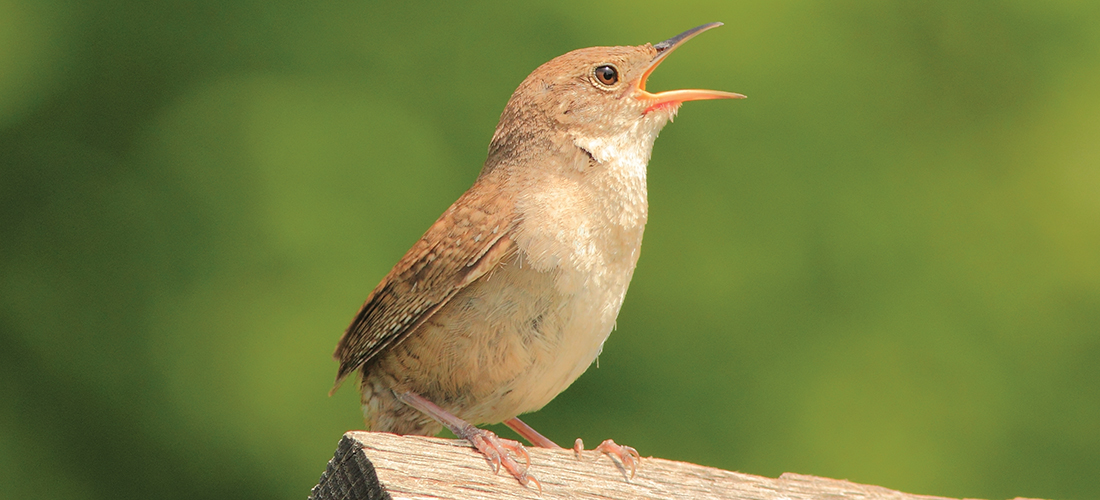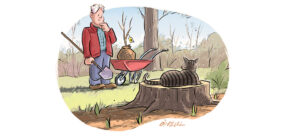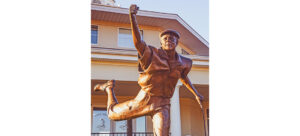
Beak House
This time of year sees a hot real estate market for house wrens
By Susan Campbell
Throughout the Piedmont and Sandhills, Carolina wrens are year-round residents easily recognized by their handsome rufous coloring, prominent white eyebrows, cocked up tails and loud voices. The emphatic “chirpity, chirpity, chirp” calls are made primarily by males, although, from time to time, females may join the chorus. These inquisitive birds, foraging almost nonstop in all sorts of nooks and crannies looking for bugs, are known to find their way into garages and even homes if there is a crack large enough for them to squeeze through. In addition, they seek out protected places to nest, often using front door wreaths, mailboxes, hanging baskets and manmade objects of all kinds.
House wrens, on the other hand, are a bit smaller and drabber in coloration. Both the male and female are gray-brown with faint streaking on wings and tail. These diminutive birds are just as feisty as their more familiar cousins. Their song, however, is a lovely mix of bubbling notes that carries quite a way. House wrens, too, are voracious insectivores, found in close association with people.
Once upon a time, they were considered seasonal migratory visitors to both the Piedmont and Sandhills, skulking in thick vegetation during spring and fall migration. In 1922, house wrens were seen nesting in the Piedmont and are now found commonly around Raleigh, and from Greensboro to Charlotte. The first documented, known successful breeding attempt in Moore County was sighted in Pinehurst during the summer of 2007. Since then a few pairs have been reported from Whispering Pines, as well as pockets around the Village of Pinehurst. However, these birds are easily overlooked by folks unfamiliar with the species. At this point, they are almost certainly breeding in more locations in at least the northern half of the Sandhills.
House wrens have a breeding strategy that allows them to colonize new habitat quickly. Females typically produce two sets of four to seven young each summer. The males are frequently polygamous. Interestingly, a female may move to the territory of a different male for the second nesting. And female house wrens are known to raise broods in quick succession. The male may finish raising the first brood as the female begins nest-building for round two.
Unlike Carolina wrens, house wrens are cavity nesters, so they will use bird boxes readily. Small holes are hard to come by on the human-altered landscape — but birdhouses are not. With increased urbanization and the widespread interest in providing for birds, more boxes are appearing on the landscape every spring. Although house wrens will use a box that is pole- mounted, they actually prefer hanging houses. It is possible that this is because dangling accommodations are less likely to be invaded by predators.
The challenge that house wrens no doubt have been facing here in the Sandhills as they attempt to become established, is available “real estate.” When they return to nest in mid-April, the bluebirds, as well as our nonmigratory chickadees, nuthatches and titmice have not only claimed a large percentage of the available bird houses but are also well into incubation. House wrens then must search for an empty box. If you are interested in providing for these uncommon little birds, it is best to wait to hang a suitable box until about April 15. Also you might want to consider a box with a smaller (1-inch or 1 1/2-inch) entrance that will exclude larger cavity nesters. If you happen to attract house wrens, please let me know. We are still very interested in the progress of these birds as they continue their southward dispersal here in central North Carolina. OH
Susan would love to receive your wildlife sightings and photos. She can be contacted by email at susan@ncaves.com.





